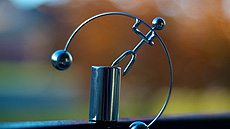Is the universe balanced on a pinhead?
 |
New precise measurements of the mass of the top quark bring back the question: Is our universe inherently unstable? Photo courtesy of Colin Harris, Flickr |
Scientists have known the mass of the heaviest fundamental particle, the top quark, since 1995.
But recent, more precise measurements of this mass have revived an old question: Why is it so huge?
No one is sure, but it might be a sign that our universe is inherently unstable. Or it might be a sign that some factor we don't yet understand is keeping us in balance.
The top quark's mass comes from its interaction with the Higgs field, which is responsible for the delicate balance of mass that allows matter to exist in its solid, stable form.
"The top quark is the heaviest known particle and talks the most to the Higgs field," says Fermilab theoretical physicist Joe Lykken.
Because the top quark is deeply intertwined with the Higgs field, physicists use it as a probe to examine its properties, such as its stability under different circumstances.
But when scientist plug the measured mass of the top quark into their equations based on everything they know about the Standard Model of particle physics, something very odd happens.
"When we run the Standard Model equations up to high energies, there is a region where the Higgs field shouldn't be there," says CMS experimental physicist and Rice University professor Karl Ecklund. "There, the vacuum, which is normally filled with the Higgs field, could have a negative energy."
If this prediction is correct, the Higgs field is precariously balanced only in its current state and could at any moment topple into another, more stable one.
Read more
—Sarah Charley
|